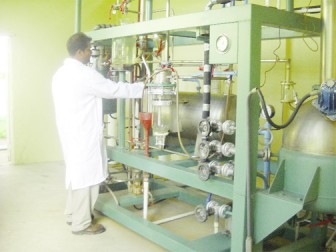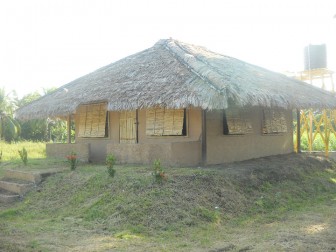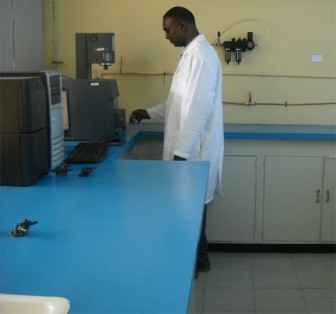Amid questions about its output, the Institute of Applied Science and Technology (IAST) says it is poised to make an impact on the economy but private sector support is crucial to fulfill the potential of its proven areas of research.

At the moment its primary output is biofuels for 200 cars while other ideas are on the table. IAST was formed in 1977 with a mandate to carry out research into Guyana’s natural resources and develop same for the benefit of Guyana but the organization fell on hard times less than a decade after its formation and functioned thereafter at a low level.
In 2005, the government decided to resuscitate the research and development institute and hired Canadian-based Guyanese scientist, Dr Suresh Narine to transform it.
During an interview last week with Stabroek News, Dr Narine noted that when he was installed as the head of the institution, it became clear to him that a huge task lay ahead and with four qualified staff members, the group worked towards developing the institute and carving out work programmes to fulfill its mandate.

“Right now we are at a stage where we are ready to go out there, we have all the research, it wasn’t easy at all, but we stuck through it and we are now ready to put our proven and tested programmes into commercial and economic use”, Dr Narine noted.
He recounted that when the institute’s resuscitation began in 2005, he and his four technical staff members developed ideas and programmes which he noted were extensively discussed and assessed to see whether they made economic sense. He said that in the initial phases, the administration had to renovate the key facilities at the IAST grounds at Turkeyen.
“The labs, the buildings which you see here today, were all in a bad shape and we have had to completely bring these up to scratch”, Dr Narine noted.

Each year the institute has received increased funding from the government to carry out its works. In 2006 IAST was provided with $12M for its capital work programmes. This year, some $118M was budgeted for the agency by the government.
Dr Narine said that he believes capacity building is an important factor where the institute is concerned adding that it is an essential requirement in order to be able to measure the impact of the technology utilized by the institute. “Whether they are for marketing or developing new products which can be commercialized, or technology transfer from elsewhere, which requires some amount of reworking of the process”.
Today the organization boasts 20 technical staff and five administrative staff members.
As regards what sectors of the economy the work programmes target, Narine said, “The idea is that we want to have an impact on the national strategies of development”, adding that IAST’s main areas of research revolve around agriculture, mining, construction and the energy sector. “Those are the main pillars of economic development in the country” he noted.
IAST has worked on several areas of research, mainly bio-fuels, indigenous materials (projects aimed at formulating products out of used materials) and development of its bio-prospecting capacity.

The institute embarked on a bio-diesel project soon after its resuscitation, in 2006, which saw the utilization of palm oil from the Wauna community in Region One. The community had produced palm oil in the past for similar government projects.
The bio-diesel progamme continued thereafter, and the institute developed its technological base to use other organic substances, such as the waste oil used in Chinese restaurants to produce the fuel. Today some 200 vehicles which operate along the coastland, including most diesel manufactured vehicles operated by the institute, utilize IAST’s biofuel.
According to the IAST website, the process of producing the biofuel involves the utilization of various feedstock available in Guyana (used vegetable oil from a variety of sources, and both crude and refined vegetable oils (palm, coconut, canola, soy, jatropha, etc.) to produce B100 Biodiesel. The feedstock was first analyzed in IAST’s laboratory to determine the various parameters such as fatty acid content, fatty acid profile, viscosity, etc.
Staff were then trained in the production of quality biodiesel and in analytical procedures to test both the feedstock and finished fuel for quality control parameters. Different parameters for the production of quality biodiesel were developed and documented for each type of feedstock available.
Using processing requirements procured from laboratory scale experiments, and elements of design from a variety of internationally available pilot and commercial scale equipment, IAST staff designed and constructed a unique pilot plant for the production of quality B100 Biodiesel using a feedstock available locally.
This plant, Dr Narine noted, is unique since it was constructed entirely out of local materials. He said too that it is designed to function in any environment. He said that considering the Low Carbon drive, the plant is environmentally friendly.
The indigenous materials projects are aimed at retrieving the usable content of plant and food materials, among others, and transferring these for use by man. IAST has used extrusion technology in this project area. For instance, Dr Narine noted that the technology to make roof tiles, noodles and other products is one that is extrusive in nature. The projects can develop to be commercially viable and according to Dr Narine, IAST has all the relevant facilities to work with private entities in commercializing such projects. “We have all the ingredients here”, he stated.
“In our indigenous materials projects we are doing a lot of chemistry using available technology, the institute is able to extract the ethyl laurate content of materials, such as coconut oil”, he said. He noted that the specific chemical compound, is present in cosmetics and as such, “we are suggesting that you take coconut oil, fractionate it, take out the ethyl laurate content and you have your coconut oil as well as the chemical makeup for cosmetics”.
The future of IAST
Using its technological base, in the main areas of research and development, Dr Narine asserted that IAST will be the leading research institute in the Caribbean. “In fact we are already ahead of some nations”, he added, noting that Trinidad and Barbados have only recently begun research in areas which IAST has had working knowledge of for the past two years.
He said that after five years of hard work, the staff at the institute is capable of carrying out the agency’s mandate but he noted that more can be done in terms of enhancing the human resource capabilities at the institute. As such, the body is pursuing the possibility of having staff pursue their masters at the Trent University in Alberta, Canada, where he is based as a senior industrial research expert.
At the same time the body plans to collaborate with the University of Guyana to have students pursue their practicals using IAST’s state-of-the-art facilities, on projects which can have a national impact.





